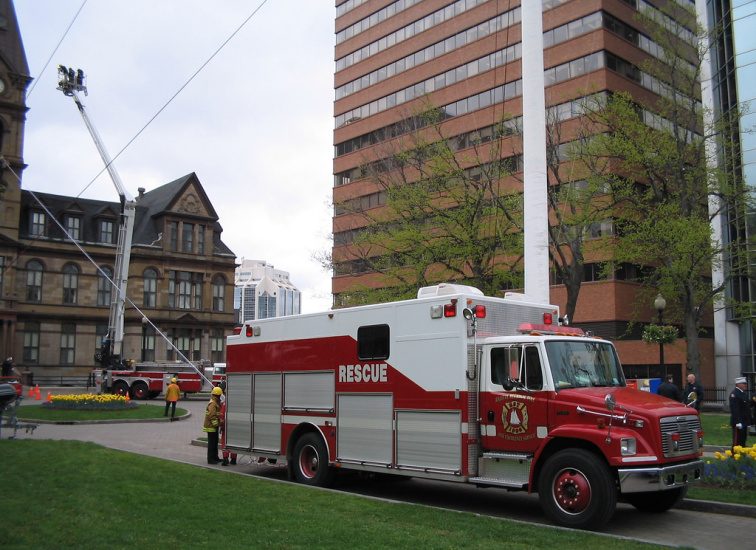by District Chief and Restorative Lead Kevin Reade
With thank you to the ‘International Restorative Justice Journal’ which first published this article and to District Chief (DC) Kevin Reade for allowing the Nova Scotia Advocate to republish it.

Halifax, Nova Scotia, has a 250-year history of Black migration that is fraught with inequality and racism. Because of the conflict between the African Nova Scotians and white community, the city of Halifax in 1988 found itself at the centre of race riots. The city’s response was to implement an affirmative-action programme designed to employ Blacks in hopes to quell the racial upheaval. As a result, I started my 28-year career with the Halifax fire department in 1990. It was the oldest fire department in Canada and one of the most racist fire departments in Canada. It was evident from the start that the department hired me because they had to, not because they wanted to.
I experienced incidents of discrimination and racism from other members of the fire service, management and even the public. In 1990, myself and one other Black member went through the hiring process, and recruiters took pictures of all participants. After the test they sent a letter to all applicants who had written and said, ‘If you’re Black, and you made over 50% on the exam give us a call’. With the pass mark being 70% for the remainder of the population, you could imagine how that incited the public. The irony was that we both achieved a pass mark higher than 70%, but that did not matter. Things were said to me like, ‘You don’t deserve to be a Halifax Firefighter. You’ve taken my son’s job’.
In 1996 Halifax fire amalgamated with five smaller fire departments to form the Halifax Regional Fire and Emergency Service. All six departments brought their own unique cultures, and along with that came a lot of problems. The fire service, not unlike other uniform services, had engrained in their culture racism, sexism, favouritism and nepotism.
In 2001 the fire service, with best intentions, decided to have a dedicated all-Black hire, but neglected to prepare the service or any of its providers for the entry of ten Black firefighters. Whenever people hear ‘affirmative-action programme’ or ‘all-Black hire’, the popular misconception is that somehow the job standards are lowered for that certain group of people or that they are just not as good. This continues to perpetuate unfairness and inequality.
When the ten Black recruits came into the fire service they were sent to the local fire school to receive their level one fire training. This fire school was under contract with the fire service to train its members before they entered the workforce. Let me paint a picture of this fire school: You are driving along and it is the year 2004. You turn left on a dirt road and you are vaulted back in time 40 years earlier to the attitudes about gender and race popular at that time. That is what the experience was for these firefighters. The school had a capacity for twenty students, ten reserved for Black firefighters (who already had a job) and ten for the public (who wanted those jobs). While attending training at the fire school, the designated recruits were subjected to overt racism and unprofessional treatment at the hands of fire school instructors, and other students. In one incident, a dark-skinned member of the Designated Recruit Class was told by a fire school instructor to ‘smile, I can’t see you.’ On the last day before graduation, the school threw a celebration and the students stayed overnight. In the morning, they got up and prepared for all the families and friends coming to attend. It was on that same morning that one of the instructors let two Black recruits know that they would not be graduating.
After the new recruits graduated and started working, these stories came to light. When management found out about what went on they responded in a fashion that was typical of their approach; they ignored the injustice in the hope that it would go away. In fact, the more the Black firefighters complained the more we were intimidated, bullied and harassed. We looked for help from the Chief administrative officer, human resources and the union, but to no avail. By this time, because of the lack of support from the service at large, we decided to form the Halifax Association of Black Firefighters (HABFF). The division along racial lines in the department worsened, as the membership asked questions like, ‘Why do you need to separate? Why do you have to form your own group?’ The union thought we were trying to circumvent them and the Chief called us a ‘special interest group’ and the bullying and harassment continued.
The only choice we had left was to lodge an official complaint with the Human Rights Commission. As a group, the HABFF compiled a document called The struggle for acceptance that reported incidents of racism that were experienced and management’s subsequent failure to address them. After an extremely lengthy initial investigation our case was referred to a Human Rights Board of Inquiry. At that point we were given the option to hit the service hard and try to exact a pound of flesh through an adversarial hearing or handle it restoratively. This is where I met Jennifer Llewellyn, hired by the Commission to guide one of the largest human rights cases brought forward in Canada, to navigate this complaint through a restorative process to a peaceful resolve.
Because of this high-profile case and the attention that it garnered, the city took a hard look into the management of the fire service and did not like what they saw. To foster a more egalitarian culture the upper echelon of the fire service who were felt most representative of the old guard style of management departed. A new Chief was hired to see this process through and begin culture change.
After hearing about the core values of what restorative justice was I realised that this is how I would choose to live my life. It is how I raise my children, and conduct myself daily at work and home. Fire on the other hand could not spell the word ‘restorative.’ At the initial circles, management came in with a defensive attitude, ready to be right and unable to assume responsibility. Reparation was a totally new concept for them. We sat through multiple circles over the next 18 months of the restorative process and in the end, seven long years after filing our human rights complaint we had a successful completion. All the parties involved came up with an agreement that consisted of 26 points that would be implemented for effective culture change.
The agreement included a commitment to implement a restorative approach within the fire service. Management tried twice unsuccessfully to initiate this. I am proud to say that I was promoted in 2016 and was given the daunting task to implement this approach and be successful. I would like to give you an overview of the potential and significance of a restorative approach for dealing with and addressing issues of inclusion and building a healthy workplace climate drawn from my experience. The following are specific points to consider.
A restorative approach fosters an employee-centred framework for success
We get a chance to do things differently. In the fire service, like most uniform services, when a person has been found to do something wrong, instead of addressing the singular behaviour, we label their entire professional identity. This is because we have one simple way of dealing with things, and that is to assume the worst and punish accordingly. As a result, we lose good people with clever ideas and lots of drive by turning them into tired, ‘toe the line’ types with no initiative, who count the days to retirement. With a restorative approach, we have a chance to mentor rather than beat up, guide rather than beat down and give people the tools they need to overcome their mistakes and flourish rather than be labelled and marked by them. Errors and bad attitudes become opportunities for change to empower people rather than the measure by which they are reduced. It also gives people a chance to connect with the things that they desire in a close-knit group. People want to feel like they belong, that they have something to contribute, they have a voice and that they can be heard. A restorative approach meets these needs and can empower people to enter in and take a meaningful role in the workplace.
The connection to how discipline is dealt with in the fire service
Consequence is at the heart of every action both good and bad. A restorative approach is not necessarily different. Discipline does not have to be synonymous with punishment. In a worst-case scenario if actions are extremely damaging or dangerous there may be a few options to correct behaviour and ensure a safe working environment. However, if the response includes sharing experiences and considering the effects personal actions have on others, the outcome, even if it includes discipline has better potential of being successful and ensuring that the behaviour and the harmful impacts are not being repeated.
The challenges and opportunities of working restoratively in a command and control environment
The engrained culture of a punitive work environment is a liability to a successful restorative approach. For leadership to effect change in this established culture we need skills in listening, teambuilding, conflict transformation and empowerment of those underneath us. But in the fire service we have had a system that promotes officers based on their aptitude and willingness to enforce rules and ability to command a scene. We have done a wonderful job at evaluating and promoting great fire ground officers. This includes those who command an emergency while working under pressure. However, these are not the same skills needed to build and lead a crew outside a fire scene. Yet, all our interpersonal relationships in the workplace were handled this same way as if they could be managed and controlled. The approach demanded that orders be followed with no input. People are perceived as resources to be managed and deployed. This fire ground mentality is essential for effective chain of command and fire ground tactics at a scene. But these same officers who are brilliant on the fire ground commanding skilled crews could not maintain healthy and safe relations among crews in the stations. One hundred per cent of our training is oriented to excellence in fighting fires; the problem is we only fight fires 10% of the time; the rest is living, learning and working together. For this we needed relational skills. We needed an approach to being excellent fire crews on and off the fire ground.
One of the major challenges in implementing a restorative approach focused on these relational skills and work is buy in: we do not understand what being restorative means. This is true right across the board in the department and the city. The lack of understanding is not just a failure to define restorative. It is connected to misconceptions in at least four ways: (1) management thinks restorative is about taking away the right to discipline; (2) corporate human resources believe it is a tool to put in their tool kit for conflict resolution but that it does not have any greater implications for policy and practice; (3) the union believes it is a way of circumventing punishment; and (4) the membership believes that all we do is hold hands and hug. These misunderstandings are, in part, a reflection of the perspective and interests that these different groups bring to their roles. Those who have first-hand experience of the approach have shifted their views but it is difficult and slow to overcome these misperceptions in order to engage people in processes and requires changing hearts and minds one process at a time. But this is the journey we have embarked on. Taking the opportunities to respond differently and to approach life in the stations differently as they arise.
For example, we have 33 rural/composite and 17 core stations. When new recruits are hired and new officers are promoted, they are posted together to the 33 rural stations. We started delivering restorative/relational training to all new hires and officers. We give them the tools for effective communication, building and maintaining relationships, and most importantly, the ability to understand that their actions can impact others and their community. The feedback from the new members has been amazing. We are effectively changing the fire service from the ground up, because these new officers and recruits will be the leaders of tomorrow.
Leadership that embraces a restorative approach will foster and build strong relationships. It will promote inclusivity, respect, empowerment, fairness, kindness and help to build the capacity for addressing conflict before it escalates. If we attempted to live and work according to those values, people would experience fewer harmful events in the long run.
Kevin Reade is Restorative Lead, District Chief, “A” Platoon, Fire & Emergency Service, Halifax Regional Fire & Emergency, Nova Scotia, Canada. Contact author: readek@halifax.ca
With a special thanks to our generous donors who make publication of the Nova Scotia Advocate possible.
Subscribe to the Nova Scotia Advocate weekly digest and never miss an article again. It’s free!



